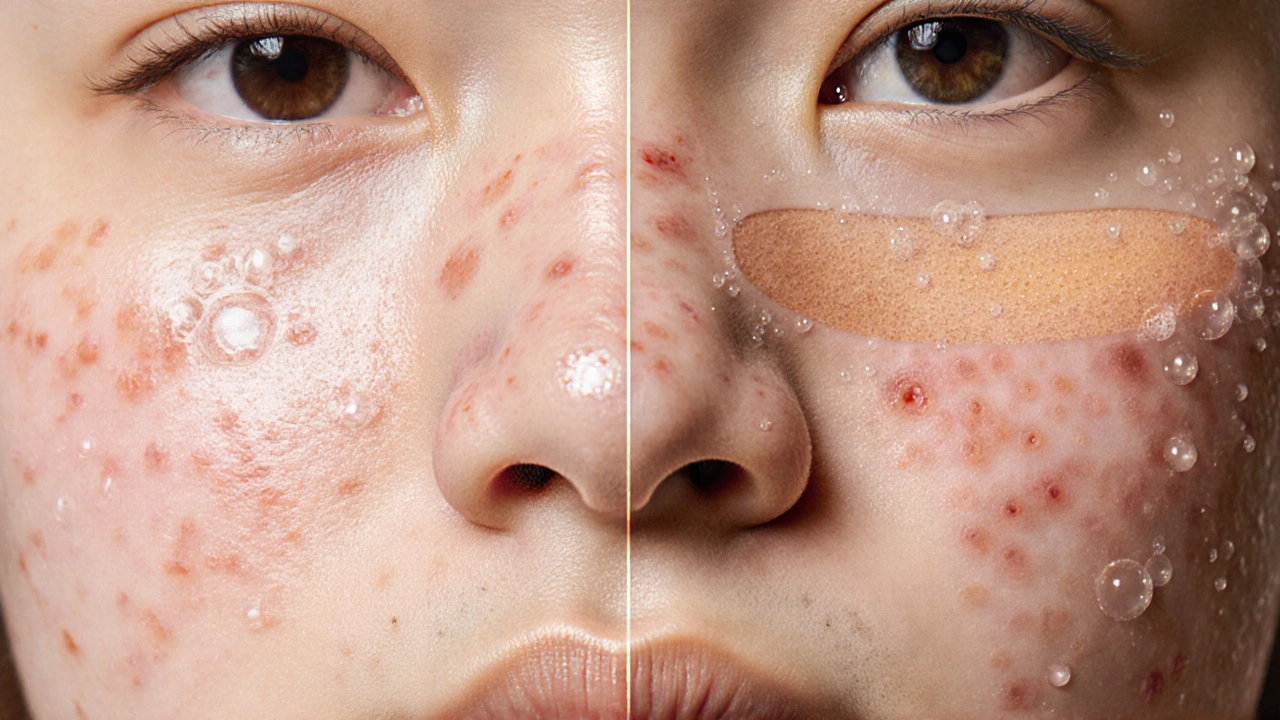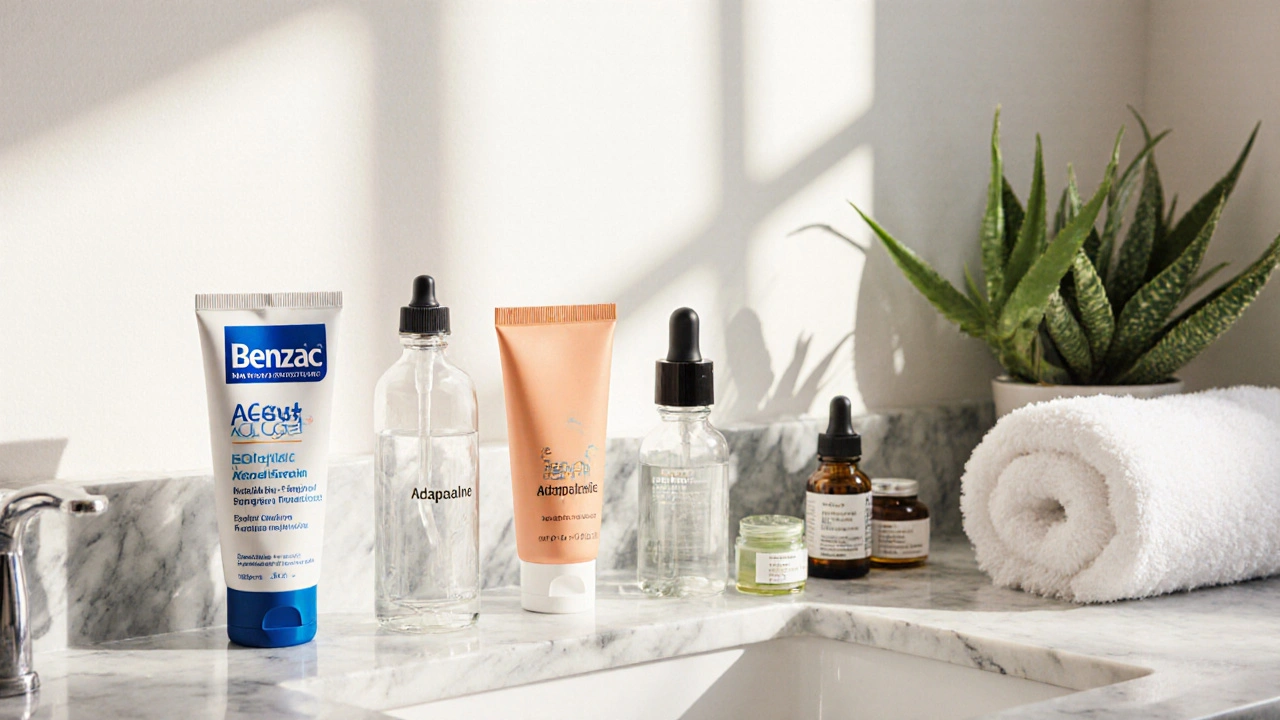Acne Treatment Selector
Select Your Skin Type
Select Your Main Concern
Current Treatment
Benzac AC Gel is a topical acne treatment that contains 5% benzoyl peroxide, an antimicrobial and keratolytic agent. It works by killing the bacteria that cause pimples and unclogging pores. If you’ve tried generic gels and still see breakouts, you’re probably wondering whether a different active ingredient might suit you better. This guide breaks down the science, cost, and skin‑type match‑ups of the most common alternatives so you can decide if Benzac AC Gel remains your go‑to or if it’s time for a switch.
How Benzac AC Gel Works
Benzoyl peroxide releases free‑radical oxygen that oxidizes Cutibacterium acnes, the bacteria that thrive in oily pores. The oxidative burst also speeds up skin cell turnover, preventing dead cells from clogging the pore opening. Typical results appear within 3‑5 days, though full clearance can take up to 12 weeks. The main downside? A dry, flaky sensation that many users mask with moisturizers.
Salicylic Acid: The Exfoliating Ally
Salicylic Acid is a beta‑hydroxy acid (BHA) that dissolves the glue‑like substance holding dead skin cells together. Because it’s oil‑soluble, it penetrates sebum‑filled pores and loosens blockages from the inside. Concentrations range from 0.5% in gentle daily cleansers to 2% in spot‑treatment gels. Users love the smoother texture, but high percentages can sting sensitive skin.
Adapalene: The Gentle Retinoid
Adapalene is a third‑generation retinoid that normalizes cell turnover without the severe irritation of older retinoids. It binds to specific nuclear receptors, prompting the skin to shed old cells faster while reducing inflammation. Over‑the‑counter options (0.1% gel) are available, and prescription strengths reach 0.3%. The trade‑off is a few weeks of redness before the clear‑skin payoff.
Azelaic Acid: The Multi‑Tasker
Azelaic Acid is a dicarboxylic acid derived from grains that offers antibacterial, keratolytic, and melanin‑inhibiting effects. At 15% concentration it’s effective for both inflammatory acne and post‑inflammatory hyperpigmentation. Its mildness makes it a favorite for rosacea‑prone skin, though the texture can feel gritty for some.
Clindamycin: The Antibiotic Option
Clindamycin is a topical antibiotic that blocks bacterial protein synthesis, reducing the load of Cutibacterium acnes. Often combined with benzoyl peroxide to prevent resistance, a 1% gel can halve lesion counts within weeks. The major downside is the risk of developing antibiotic‑resistant strains if used long‑term.
Tea Tree Oil: The Natural Antiseptic
Tea Tree Oil is an essential oil rich in terpinen‑4‑ol, a compound that displays broad‑spectrum antimicrobial activity. When diluted to 5% in a carrier oil, it reduces inflammation and kills acne‑causing bacteria. Results are slower than chemical actives, and a strong scent can be off‑putting for some users.

Niacinamide: The Barrier Builder
Niacinamide (vitamin B3) strengthens the skin barrier, reduces sebum output, and lightens redness. Formulations typically sit at 5% in serums and work well alongside other actives. It won’t clear severe cystic acne alone, but it smooths texture and curbs flare‑ups.
Side‑by‑Side Comparison
| Product | Active Ingredient | Typical Conc. | Mechanism | Best For | Common Side Effects | Price (USD) |
|---|---|---|---|---|---|---|
| Benzac AC Gel | Benzoyl Peroxide | 5% | Oxidative antibacterial & keratolysis | Moderate‑to‑severe papules | Dryness, peeling | 8‑12 |
| Clearasil 10% Gel | Benzoyl Peroxide | 10% | Stronger oxidative action | Robust breakout control | More irritation | 6‑9 |
| Differin Gel | Adapalene | 0.1% | Retinoid‑mediated cell turnover | Comedonal & inflammatory acne | Redness, mild burning | 12‑16 |
| Paula’s Choice 2% BHA | Salicylic Acid | 2% | Oil‑soluble exfoliation | Blackheads & oily skin | Stinging if over‑applied | 18‑22 |
| Azelaic Acid Cream | Azelaic Acid | 15% | Antibacterial + melanin inhibition | Acne & hyperpigmentation | Temporary tingling | 25‑30 |
| Tea Tree Oil Solution | Tea Tree Oil | 5% (diluted) | Broad‑spectrum antimicrobial | Mild to moderate acne | Possible irritation, scent | 10‑14 |
| Niacinamide Serum | Niacinamide | 5% | Barrier reinforcement & sebum regulation | Redness, post‑inflammatory marks | Rare irritation | 15‑20 |
Choosing the Right Treatment for Your Skin Type
Think of acne care as a three‑part equation: kill the bacteria + unclog the pores + calm the inflammation. Benzac AC Gel nails the first two parts but can leave the third-irritation-unaddressed. If your skin tolerates the dryness, it remains a solid starter. For oily, acne‑prone teens who can’t handle peeling, a salicylic‑acid cleanser (Paula’s Choice) often feels lighter while still keeping pores clean.
Retinoid lovers-especially those who gravitate toward anti‑aging-might opt for Adapalene because it offers long‑term skin‑tone benefits with less flare‑up risk than older retinoids. When hyperpigmentation is a concern, azelaic acid shines by fading dark spots while still acting on the acne itself.
For patients worried about antibiotic resistance, pairing benzoyl peroxide with a low‑dose Clindamycin gel can give a quick kill‑off without creating resistant strains.
Those preferring a natural route might stick with tea tree oil, but they should temper expectations: the healing curve is slower, and consistent twice‑daily application is key.
Practical Tips for Safe Use
- Start with a small patch-apply a pea‑sized amount to the jawline and wait 24hours for any reaction.
- Layer moisturizers after the active dries (about 5‑10minutes) to lock in hydration.
- Limit sun exposure; benzoyl peroxide and retinoids increase photosensitivity.
- If you combine actives (e.g., benzoyl peroxide + salicylic acid), use them on alternate evenings to avoid cumulative irritation.
- Give each product at least six weeks before deciding it’s ineffective; acne cycles are slow.
Related Concepts and Next Steps
Understanding the role of sebum production helps you tailor your regimen. High‑oil skin thrives with oil‑soluble BHAs, while dry skin benefits from barrier‑strengthening agents like niacinamide. If you’ve tried over‑the‑counter options without success, a dermatologist can prescribe oral isotretinoin-a systemic solution that targets the root cause-but it comes with strict monitoring.
Future reads could explore:
- “When to Switch from Topical to Oral Acne Meds”
- “The Science Behind Post‑Inflammatory Hyperpigmentation”
- “DIY vs. Commercial Spot Treatments: What Works?”
Bottom Line
If you value fast‑acting bacterial control and can handle mild dryness, Benzac AC Gel remains a reliable choice. For smoother textures, less irritation, or added pigment correction, alternatives like salicylic acid, adapalene, or azelaic acid may serve you better. The key is to match the active’s mechanism with your skin’s primary complaint and to introduce any new product gradually.
Frequently Asked Questions
Can I use Benzac AC Gel and a salicylic acid cleanser together?
Yes, but alternate them-use benzoyl peroxide at night and the salicylic acid cleanser in the morning. This prevents overlapping irritation while still targeting bacteria and oil.
How long does it take to see results with Benzac AC Gel?
Most users notice reduced redness within 3‑5 days, but visible lesion clearance typically requires 8‑12 weeks of twice‑daily use.
Is Benzac AC Gel safe during pregnancy?
Benzoyl peroxide is generally considered low‑risk, but always consult your OB‑GYN before starting any new acne medication while pregnant.
What should I do if my skin becomes too dry?
Cut back to once daily, add a fragrance‑free ceramide moisturizer, and avoid other drying actives like strong retinoids until the barrier recovers.
Can I combine Benzac AC Gel with a prescription oral antibiotic?
Yes, the combination is common and can speed up improvement. Your dermatologist will set the dosage and monitor for side effects.

Great rundown! 😊 If you’re new to benzoyl peroxide, start slow and pair it with a gentle moisturizer.
Appreciate the balanced view. Knowing which ingredient tackles your primary concern really helps keep expectations realistic.
Short and sweet: stick to one active at a time to see true results.
I love how it breaks down the options, but dont forget to patch test before going full‑blast.
Sure, benzoyl peroxide works, but if you’re okay with a little dryness, why not just slap on some clindamycin and call it a day?
Whoa, this guide is a goldmine! 🌟 I’ve tried the 5% gel and felt the “peel‑and‑heal” magic within a week. The way it tackles both bacteria and clogged pores is like a double‑shot espresso for breakouts. If you’re an oily‑skin warrior, mixing it with a BHA cleanser on alternate nights can keep the shine at bay without turning your face into a desert. Just remember: always lock in moisture after the gel dries – a lightweight ceramide works wonders. And hey, sunscreen isn’t optional; those peroxide‑boosted skin cells love sunlight a bit too much. Keep experimenting, but be patient – the skin’s renewal marathon takes time.
Interesting breakdown, though the table could use more pharmacodynamic jargon. Yet, the recommendation to alternate actives is standard of care, so kudos for reinforcing that protocol.
Wow!!! This article, it's... comprehensive, thorough, detailed!!! The inclusion of both OTC and prescription options, the clear mechanism-of-action notes-absolutely invaluable, especially for those researching treatment algorithms!!!
Stick to what works; if benzoyl peroxide dries you out, add a barrier repair serum and you’ll be fine.
Oh great, another “choose your fighter” guide. Because nothing says “confidence” like a 2% BHA vs. a 5% peroxide showdown.
Totally agree with the gentle start advice! 👍 Pairing it with a non‑comedogenic moisturizer can really tame that initial flakiness.
The drama of acne treatments mirrors the theater of life-each act (gel, serum, retinoid) plays its part, yet the audience (your skin) remains the ultimate judge.